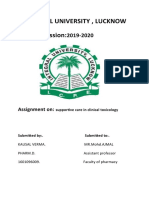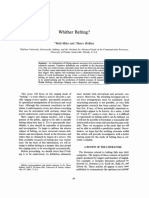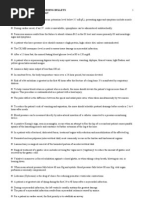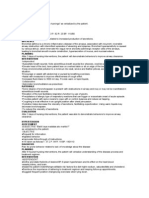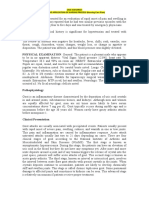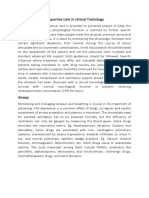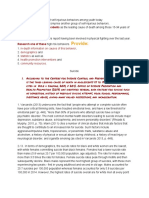Chapter 22 - Management of Patients With Upper Respiratory Tract Disorders (INCOMPLETEon 13)
Chapter 22 - Management of Patients With Upper Respiratory Tract Disorders (INCOMPLETEon 13)
Uploaded by
Mary SingletonCopyright:
Available Formats
Chapter 22 - Management of Patients With Upper Respiratory Tract Disorders (INCOMPLETEon 13)
Chapter 22 - Management of Patients With Upper Respiratory Tract Disorders (INCOMPLETEon 13)
Uploaded by
Mary SingletonOriginal Description:
Copyright
Available Formats
Share this document
Did you find this document useful?
Is this content inappropriate?
Copyright:
Available Formats
Chapter 22 - Management of Patients With Upper Respiratory Tract Disorders (INCOMPLETEon 13)
Chapter 22 - Management of Patients With Upper Respiratory Tract Disorders (INCOMPLETEon 13)
Uploaded by
Mary SingletonCopyright:
Available Formats
Chapter 22 - Management of Patients with Upper Respiratory Tract Disorders1
Handwashing remains the most effective preventive measure to reduce
the transmission
of organisms. Taking prescribed antibiotics, using warm salt-water gargles,
and
dressing warmly do not suppress transmission. Antibiotics are not prescribed
for a cold.
For a patient diagnosed with acute sinusitis, the nurse should instruct the
patient that
hot packs, increasing fluid intake, and elevating the head of the bed can
promote
drainage. Applying a mustard poultice will not promote sinus drainage.
Postural
drainage is used to remove bronchial secretions
Management of acute laryngitis includes resting the voice, avoiding
irritants (including
smoking), resting, and inhaling cool steam or an aerosol. Fluid intake should
be
increased. Warm cloths on the throat will not help relieve the symptoms of
acute
Laryngitis.
If pressure to the midline septum does not stop the bleeding for epistaxis,
additional
treatment of silver nitrate application, Gelfoam, electrocautery, or
vasoconstrictors may
be used. Suction may be used to visualize the nasal septum, but it does not
alleviate the
bleeding. Irrigation with a hypertonic solution is not used to treat epistaxis.
ineffective airway clearance is the priority nursing diagnosis for all
conditions.
For a patient who will be discharged from the hospital shortly after his
laryngectomy, the nurse should stress the importance of humidification
at home and instructs the family to obtain and set up a humidification
system before the patient returns home. Air- conditioning may be too cool
and too drying for the patient. A water purification system or a radiant
heating system is not necessary.
Hoarseness is an early symptom of laryngeal cancer. Dyspnea,
dysphagia, and lumps
are later signs of laryngeal cancer. Alopecia is not associated with a
diagnosis of
laryngeal cancer.
Chapter 22 - Management of Patients with Upper Respiratory Tract Disorders2
Cromolyn (Nasalcrom) inhibits the release of histamine and other
chemicals. It is
prescribed to treat allergic rhinitis. Beta-adrenergic agents lead to
bronchodilation and
stimulate beta- 2 adrenergic receptors in the smooth muscle of the bronchi
and
bronchioles. It does not affect proton pump action or the sodium-potassium
pump in the
nasal cells.
patient who presents with a severe nosebleed. The site of bleeding
appears to be the anterior portion of the nasal septum. The nurse
instructs the student to tilt her head forward and the nurse
appliespressure to the nose, but the student's nose continues to bleed.
Which intervention should the nurse next implement?
A cotton tampon may be used to try to stop the bleeding. The use of ice
on the bridge of
the nose has no scientific rationale for care. Laying the client down on the
cot could
block the client's airway. Hospital admission is necessary only if the bleeding
becomes
Serious.
The ED nurse is assessing a young gymnast who fell from a balance
beam. The
gymnast presents with a clear fluid leaking from her nose. What should the
ED nurse
suspect?
Clear fluid from either nostril suggests a fracture of the cribriform plate
with leakage of
cerebrospinal fluid
Immediately after the fracture, the nurse applies ice and encourages the
patient to keep
the head elevated. The nurse instructs the patient to apply ice packs to the
nose to
decrease swelling. Dependent positioning would exacerbate bleeding and the
nose is
not irrigated. Occlusive dressings are not used.
Hereditary angioedema is an inherited condition that is characterized by
episodes of
life-threatening laryngeal edema.
Considering the known risk factors for cancer of the larynx, it is essential
to assess the
Chapter 22 - Management of Patients with Upper Respiratory Tract Disorders3
patient's history of alcohol intake. Infection is a risk in the postoperative
period, but not
an appropriate answer based on the patient's history. Depression and
nonadherence are
risks in the postoperative phase, but would not be critical short-term
assessments.
The use of topical decongestants is controversial because of the potential
for a rebound
effect. The patient should hold his or her head back for maximal distribution
of the
spray. Only the patient should use the bottle.
The nurse informs the patient about the need to take the full course of
any prescribed
antibiotic. Antibiotics should be taken for the entire 10-day period to
eliminate the
microorganisms. A patient should never be instructed to keep leftover
antibiotics for
use at a later time. Even if the fever or other symptoms are gone, the
medications
should be continued. Antibiotics do not need to be disposed of in a biohazard
receptacle, though they should be discarded appropriately.
Chronic pharyngitis is common in adults who live and work in dusty
surroundings, use
the voice to excess, suffer from chronic chough, and habitually use alcohol
and
tobacco. Caffeine and spicy foods have not been linked to chronic
pharyngitis. GERD
is not a noted risk factor.
Hemorrhage is a potential complication of a tonsillectomy. Increased
pulse, fever, and
restlessness may indicate a postoperative hemorrhage. Difficulty ambulating
and
bradycardia are not common complications in a patient after a tonsillectomy.
Infrequent
swallowing does not indicate hemorrhage; frequent swallowing does.
Obstructive sleep apnea occurs in men, especially those who are older
and overweight.
Symptoms include excessive daytime sleepiness, insomnia, and snoring.
Daytime
sleepiness and difficulty going to sleep at night are not indications of
tonsillitis or
Chapter 22 - Management of Patients with Upper Respiratory Tract Disorders4
adenoiditis. This patient's symptoms are not suggestive of laryngeal cancer.
Discharge teaching for prevention of epistaxis should include the
following: avoid
forceful nose bleeding, straining, high altitudes, and nasal trauma (nose
picking).
Adequate humidification may prevent drying of the nasal passages. Keeping
nasal
passages clear and using a tissue when blowing the nose are not included in
discharge
teaching for the prevention of epistaxis. Decongestants are not indicated.
A common postoperative complication from this type of surgery is
difficulty in
swallowing, which creates a potential for aspiration. Cardiovascular
complications are
less likely at this stage of recovery. The patient's body image should be
assessed, but
dysphagia has the potential to affect the patient's airway, and is a
consequent priority.
Beconase should be avoided in patients with recurrent epistaxis,
glaucoma, and
cataracts. Sinustop Pro and Afrin are pseudoephedrine and do not have a
side effect of
epistaxis. Singulair is a bronchodilator and does not have epistaxis as a side
effect.
The nurse also assesses the patient's general state of nutrition, including
height and
weight and body mass index, and reviews laboratory values that assist in
determining
the patient's nutritional status (albumin, protein, glucose, and electrolyte
levels). The
white blood cell count and the platelet count would not normally assist in
determining
the patient's nutritional status.
Patient education is essential when assisting the patient in the use of all
medications. To
prevent possible drug interactions, the patient is cautioned to read drug
labels before
taking any OTC medications. Some Web sites are reliable and valid
information
sources, but this is not always the case. Patients do not necessarily need to
limit
Chapter 22 - Management of Patients with Upper Respiratory Tract Disorders5
themselves to one pharmacy, though checking for potential interactions is
important.
Not all OTC medications are safe additions to prescription medication
regimens.
URIs, specifically chronic rhinosinusitis and recurrent acute rhinosinusitis,
may be
linked to primary or secondary immune deficiency or treatment with
immunosuppressive therapy (i.e., for cancer or organ transplantation).
Typical
symptoms may be blunted or absent due to immunosuppression. No
evidence indicates
damage to the transplanted organ due to chronic rhinosinusitis.
Immunosuppressive
drugs do not cause organ rejection.
A compressed nasal sponge may be used for severe nose bleed. Once the
sponge becomes saturated with blood or is moistened with a small
amount of saline, it will expand and produce
tamponade to halt the bleeding. The packing may remain in place for 48
hours or up to
5 or 6 days if necessary to control bleeding. Antibiotics may be prescribed
because of
the risk of iatrogenic sinusitis and toxic shock syndrome.
Nursing care for patients with viral pharyngitis focuses on symptomatic
management.
Antibiotics are not prescribed for viral etiologies. Surgery is not indicated in
the
treatment of viral pharyngitis. Chronic hoarseness is not a common sequela
of viral
pharyngitis, so teaching ways to prevent it would be of no use in this
instance.
Patient teaching is an important aspect of nursing care for the patient
with acute
rhinosinusitis. The nurse instructs the patient about symptoms of
complications that
require immediate follow-up. Referral to a physician is indicated if periorbital
edema
and severe pain on palpation occur. Clear drainage and blood-tinged mucus
do not
require follow-up if the patient has acute rhinosinusitis. A persistent
headache does not
necessarily warrant immediate follow-up.
Chapter 22 - Management of Patients with Upper Respiratory Tract Disorders6
Colds are highly contagious because virus is shed for about 2 days before
the symptoms
appear and during the first part of the symptomatic phase. Antibiotic
resistance is not
relevant to viral illnesses and OTC medications do not have a rebound
effect. Genetic
factors do not exist.
Depending on the severity of the pharyngitis and the degree of pain,
warm saline
gargles or throat irrigations are used. The benefits of this treatment depend
on the
degree of heat that is applied. The nurse teaches about these procedures
and about the
recommended temperature of the solution: high enough to be effective and
as warm as
the patient can tolerate, usually 105F to 110F (40.6C to 43.3C). Irrigating
the throat
may reduce spasm in the pharyngeal muscles and relieve soreness of the
throat. You
would not tell the parent teacher organization that there is no real treatment
of
Pharyngitis.
The nurse explains how to apply direct pressure to the nose with the
thumb and the
index finger for 15 minutes in case of a recurrent nosebleed. If recurrent
bleeding
cannot be stopped, the patient is instructed to seek additional medical
attention. ASA is
not contraindicated in most cases and the patient should avoiding blowing
the nose for
an extended period of time, not just 45 minutes.
Due to the risk for aspiration following laryngetomy, the nurse keeps a
suction setup available in the hospital and instructs the family to do so at
home for use if needed. TPN is not indicated and small meals do not
necessarily reduce the risk of aspiration. Physical therapists do not
address swallowing ability.
Patients with nasotracheal and nasogastric tubes in place are at risk for
development of
sinus infections. Thus, accurate assessment of patients with these tubes is
critical. Use
of a nasogastric tube is not associated with the development of the other
listed
Chapter 22 - Management of Patients with Upper Respiratory Tract Disorders7
Pathologies
Antimicrobial agents (antibiotics) should not be used because they do not
affect the
virus or reduce the incidence of bacterial complications. In addition, their
inappropriate
use has been implicated in development of organisms resistant to therapy. It
would be
inappropriate to tell the patient that the physician will not respond to her
request.
The patient with a laryngectomy is a risk for airway occlusion and
respiratory distress.
As in all nursing situations, assessment of the airway is a priority over other
potential
complications and assessment parameters.
The nurse promptly notifies the surgeon of any active bleeding of a
patient who is postoperative day 1 following total laryngectomy, which
can occur at a variety of sites, including the surgical site, drains, and
trachea. The drain should not be removed or connected to suction.
Supine positioning would exacerbate the bleeding Vitamin K would not be
administered without an order.
Tracheoesophageal puncture is simple and has few complications for a
patient who is status post-total laryngectomy. It is associated with high
phonation success, good phonation quality, and steady long-term results.
As a result, it is preferred over esophageal speech, and electric larynx or
ASL.
A liquid or soft diet is provided during the acute stage of bacterial
pharyngitis, depending on the patient's appetite and the degree of
discomfort that occurs with swallowing. The patient
is encouraged to drink as much fluid as possible (at least 2 to 3 L/day). There
is no need
for increased potassium or protein intake.
The incidence of distant metastasis with squamous cell carcinoma of the
head and neck
(including larynx cancer) is relatively low. The patient's prognosis is
determined by the
oncologist, but the patient has asked a general question and it would be
inappropriate to
refuse a response. The nurse must not downplay the patient's concerns.
Chapter 22 - Management of Patients with Upper Respiratory Tract Disorders8
In patients receiving transesophageal puncture, a valve is placed in the
tracheal stoma
to divert air into the esophagus and out the mouth. Once the puncture is
surgically
created and has healed, a voice prosthesis (Blom-Singer) is fitted over the
puncture
site. A nasogastric tube and belching are not required. An artificial pharynx is
not used.
Persistent hoarseness may signal throat cancer, which commonly is
associated with tobacco use. To assess the client's risk for throat cancer, the
nurse should ask about smoking habits. Although straining the voice may
cause hoarseness, it wouldn't cause hoarseness lasting for 1 month.
Consuming red meat or spicy foods isn't associated with persistent
hoarseness.
Clients with a malignancy of the larynx require emotional support before
and after surgery and help in understanding and choosing an alternative
method of speech. It does not require a referral for counseling or vocational
training. It also does not require family counseling.
In more advanced cases, total laryngectomy may be the treatment of
choice. Partial laryngectomy, laser surgery, and radiation therapy are not the
treatment of choice for advanced cases of laryngeal cancer.
Antibiotics should be administered as soon as the diagnosis of ABRS is
established. Amoxicillin-clavulanate (Augmentin) is the antibiotic of choice.
For patients who are allergic to penicillin, doxycycline (Vibramycin) or
respiratory quinolones, such as levofloxacin (Levaquin) or moxifloxacin
(Avelox), can be used. Other antibiotics previously prescribed to treat ABRS,
including cephalosporins such as cephalexin (Keflex) and cefuroxime (Ceftin),
are no longer recommended as they are not effective in treating antibioticresistant organisms that are now more commonly implicated in ABRS.
Nuchal rigidity is the stiffness of the neck or inability to bend the neck.
Aphonia is impaired ability to use one's voice due to distress or injury to the
larynx. Xerostomia is the dryness of the mouth from a variety of causes.
Dysphagia is difficulty swallowing.
For a patient who has undergone surgery for a nasal obstruction, it is
important for the nurse to emphasize that nasal packing will be in place
postoperatively, necessitating mouth breathing. The nurse applies an ice
pack to reduce pain and swelling and not a warm pack. The nurse
recommends the use of a splint and the application of pressure to the convex
portion of the nose in case of a nasal fracture
Chapter 22 - Management of Patients with Upper Respiratory Tract Disorders9
HSV-1 is transmitted primarily by direct contact with infected secretions.
The time period 0 to 3 months exceeds the incubation period. The time
period 20 to 30 days exceeds the incubation period. The time period 3 to 6
months exceeds the incubation period.
Complications occurring late may include laryngeal necrosis, edema, and
fibrosis. Loss of taste and xerostomia are symptoms of radiation therapy that
may occur earlier in treatment.
A tracheoesophageal puncture is the method where a client speaks through
a surgical opening in the posterior wall of the trachea with the assistance of
a device. Esophageal speech occurs from swallowing air and forming words
with the lips. An electronic larynx is a throat vibrator. There is no electronic
voice box on the market.
An endotracheal tube provides a patent airway for clients who cannot
maintain an adequate airway on their own. Tracheostomy tubes are inserted
into a surgical opening in the trachea, called a tracheotomy. Clients receiving
endotracheal intubation for the purpose of general anesthesia should not
require long-term placement of the ET tube. Positive-pressure ventilators
require intubation and are used for clients who are under general anesthesia.
They are also used for clients with acute respiratory failure, primary lung
disease, or comatose.
Commonly, family members are reluctant to talk to the client who has had
a total laryngectomy and can no longer speak. To promote a supportive
environment, the nurse should encourage family members to continue
normal communication.
Pigeon chest may occur with rickets, Marfan's syndrome, or severe
kyphoscoliosis. A barrel chest is seen in patients with emphysema and occurs
as a result of over-inflation of the lungs. A funnel chest occurs when there is
a depression in the lower portion of the sternum. Kyphoscoliosis is
characterized by elevation of the scapula and a corresponding S-shaped
spine.
The nurse should instruct the client to report bleeding immediately.
Delayed bleeding may occur when the healing membrane separates from the
underlying tissue usually 7 to 10 days postoperatively. Difficulty
swallowing and throat pain are expected after a tonsillectomy and typically
are present even before the client is discharged. Sudden difficulty talking
wouldn't occur after discharge if the client could talk normally at the time of
discharge, because swelling doesn't take that long to develop.
Chapter 22 - Management of Patients with Upper Respiratory Tract Disorders
10
Major goals of intubation are to improve respirations and maintain a patent
airway for gas exchange. Regular auscultation of the lung fields is essential
in confirming that air is reaching the lung fields for gas exchange. All other
options are important to provide assessment data
An endotracheal tube is inserted through the mouth or nose into the
trachea to provide a patent airway for clients who cannot maintain an
adequate airway on their own.
Following a nasal fracture, the nurse applies ice and encourages the patient
to keep the head elevated. The nurse instructs the patient to apply ice packs
to the nose to decrease swelling. The packing inserted to stop the bleeding
may be uncomfortable and unpleasant, and obstruction of the nasal
passages by the packing forces the patient to breathe through the mouth.
This, in turn, causes the oral mucous membranes to become dry. Mouth
rinses help to moisten the mucous membranes and to reduce the odor and
taste of dried blood in the oropharynx and nasopharynx.
A sudden and complete loss of voice and cough are symptoms of laryngitis.
The nurse instructs the client to avoid irritants, such as smoking. Voice rest is
indicated. Whispering places stress on the larynx. Inhaling cool steam or
aerosal aids in the treatment. Dry air may make the symptoms worse. A
"tickle" in the throat that many clients report is actually worsened with cold
liquids.
In a partial laryngectomy, a portion of the larynx is removed, along with
one vocal cord and the tumor; all other structures remain. The airway
remains intact, and the patient is expected to have no difficulty swallowing.
During a supraglottic laryngectomy, a tracheostomy is left in place until the
glottic airway is established. Hemilaryngectomy is done by splitting the
thyroid cartilage of the larynx in the midline of the neck, and the portion of
the vocal cord is removed with the tumor. During a total laryngectomy, a
complete removal of the larynx is performed, including the hyoid bone,
epiglottis, cricoids cartilage, and two or three rings of the trachea.
Management of viral rhinitis consists of symptomatic therapy that includes
adequate fluid intake, rest, prevention of chilling, and use of expectorants as
needed. Warm saltwater gargles soothe the sore throat, and nonsteroidal
anti-inflammatory drugs (NSAIDs), such as aspirin or ibuprofen, relieve aches
and pains. Antibiotics are not prescribed because they do not affect the virus
causing the patients signs and symptoms. Topical nasal decongestants
should be used with caution. The symptoms of viral rhinitis may last from 1
to 2 weeks.
Chapter 22 - Management of Patients with Upper Respiratory Tract Disorders
11
The client with a new tracheostomy tube has increased secretions, which
may become dried and occlude the airway or plug the airway requiring
frequent suctioning. Impaired Gas Exchange is an equally important
diagnosis. These are related to airway and breathing and are priorities.
A warm saline solution will help with removal of thick mucus and halitosis.
It will be a gentle gargle, because a vigorous gargle may cause bleeding. A
sore throat may be present for 3 to 5 days. Hot foods should be avoided.
Persistent hoarseness, especially of unknown cause, can be a sign of
laryngeal cancer and merits prompt investigation. Epistaxis can be from
several causes and has occurred infrequently. Aphonia and laryngitis are
common following the noted activity.
Transillumination and x-rays of the sinuses may show a change in the
shape of or confirms that there is fluid in the sinus cavity. CBC with
differential can note an elevated white blood cell count but not confirm fluid
in the sinus cavity. A nasal culture can note bacteria in the nares. An MRI is
an expensive procedure which is not typically prescribed for a potential
infection and not specifically ordered to identify fluid in the sinus cavity.
Enlarged adenoids may produce nasal obstruction, noisy breathing,
snoring, and a nasal quality to the voice. Incrustation of the mucous
membranes in the trachea and the main bronchus occurs during the
postoperative period following a tracheostomy. The long-term and short-term
complications of tracheostomy include airway obstruction. These are caused
by hardened secretions and erosion of the trachea.
After an initial hoarseness lasting longer than a month, clients with
laryngeal cancer will feel a sensation of swelling or a lump in the throat or in
the neck. Weight loss often occurs later in the progression of laryngeal
cancer due to reduced calorie intake as a result of impaired swallowing and
pain. Clients with laryngeal cancer may complain of burning in the throat
when swallowing hot or citrus liquids. Clients with obstructive sleep apnea
may experience amorning headache.
In a partial laryngectomy, a portion of the larynx is removed, along with
one vocal cord and the tumor; all other structures remain. The airway
remains intact, and the patient is expected to have no difficulty swallowing.
During a supraglottic laryngectomy, a tracheostomy is left in place until the
glottic airway is established. Hemilaryngectomy is done by splitting the
thyroid cartilage of the larynx in the midline of the neck, and the portion of
the vocal cord is removed with the tumor. During a total laryngectomy, a
complete removal of the larynx is performed, including the hyoid bone,
epiglottis, cricoids cartilage, and two or three rings of the trachea.
The description of the fellow worker is a person who is choking. Following
Chapter 22 - Management of Patients with Upper Respiratory Tract Disorders
12
guidelines set by the American Heart Association, the nurse first stands
behind the person who is choking.
If a nurse is concerned that a client may not perform followup treatment
for streptococcal pharyngitis, the highest priority is to administer penicillin as
a one-time injection dose. Oral penicillin is as effective and less painful, but
the client needs to take the full course of treatment to prevent antibioticresistant germs from developing. The nurse should provide oral and written
instructions for the client, but this is not as high a priority as administering
the penicillin. Having a homeless friend monitor the client's care does not
ensure that the client will follow therapy.
The nurse needs to make the appropriate room assignment based on the
client's problems, safety, and risk for infection to others. The client with an
upper respiratory infection may transmit infection to susceptible people.
Clients A, C, and D have increased susceptibility for infection because of
immunosuppression or surgery.
Treatment of choice for bacterial pharyngitis is penicillin. Robitussin DM
may be used as an antitussive. For severe sore throats aspirin or Tylenol, or
Tylenol with codeine may be given.
The nurse instructs the client to blow the nose before administering the
nasal medication. The client should keep the head upright, not tilted back.
The client should wait at least 1 minute before administering the second
spray and clean the container after each use.
Your client has a history of hoarseness lasting longer than 2 weeks. The
client is now complaining of feeling a lump in their throat. What would you
suspect this client has?
Laryngeal cancer
---- >>>>>Later, the client notes a sensation of swelling or a lump in the
throat, followed by dysphagia and pain when talking. Hoarseness is not
indicative of pharyngeal cancer; laryngeal polyps; or cancer of the tonsils.
A face mask or other nasal devices are found in the clients room as this
type of ventilation does not require intubation or a ventilator. A rigid shell is
used with a negative pressure chamber and is not frequently used today. A
nasal cannula is not used with the positive pressure device.
Most cases of acute pharyngitis are caused by viral infection.
Maintaining the head in an elevated position will decrease the amount of
nasal swelling after a rhinoplasty. NSAIDs, such as ibuprofen, increase the
risk for postoperative bleeding and should not be used postoperatively.
The patient would not be taught to remove or reapply nasal packing,
which is usually removed by the surgeon on the day after surgery.
Chapter 22 - Management of Patients with Upper Respiratory Tract Disorders
13
Although return to a preinjury appearance is the goal of the surgery, it is
not always possible to achieve this result, especially in the first few
weeks after surgery.
The most important intervention for allergic rhinitis is to assist the patient
in identifying and avoiding potential allergens. Intranasal corticosteroids
(not oral antihistamines) should be started several weeks before the
allergy season. Corticosteroid nasal sprays have minimal systemic
absorption. Acute viral rhinitis (the common cold) can be prevented by
washing hands.
The nurse should clarify that nasal decongestant sprays should be used
for no more than 3 days to prevent rebound vasodilation and congestion.
This patient needs suctioning now to secure a patent airway for the
patient with a tracheostomy tube in place has just auscultated rhonchi
bilaterally. If the patient is unsuccessful in coughing up secretions....
Sterile gloves and a sterile catheter are used when suctioning a
tracheostomy. Preoxygenation for 3 minutes is not necessary. Incentive
spirometer (IS) use opens alveoli and can induce coughing, which can
mobilize secretions. However, the patient with a tracheostomy may not
be able to use an incentive spirometer. Increasing oral fluid intake would
not moisten and help mobilize secretions in a timely manner.
(radiation therapy of the larynx) Xerostomia can be partially alleviated by
drinking fluids at frequent intervals. Radiation will damage tissues at the
site being radiated but should not affect the abdominal organs, so loose
stools are not a usual complication of head and neck radiation therapy.
Frequent oral rinsing with nonalcohol-based rinses is recommended.
Prescribed lotions and sunscreen may be used on radiated skin, although
they should not be used just before the radiation therapy.
Prolonged alcohol use and smoking are associated with the development
of laryngeal cancer, which the patients symptoms and history suggest.
Family history is not a risk factor for head or neck cancer. Frequent
antihistamine use would be asked about if the nurse suspected allergic
rhinitis, but the patients symptoms are not suggestive of this diagnosis.
Streptococcal throat infections also may cause these clinical
manifestations, but patients with this type of infection will also have pain
and a fever.
Voice rehabilitation is planned after a total laryngectomy, and a variety of
assistive devices are available to restore communication. Although the
ability to communicate orally is changed, it would not be appropriate to
Chapter 22 - Management of Patients with Upper Respiratory Tract Disorders
14
tell a patient that this ability would be lost. Artificial voice devices do not
permit normal-sounding speech. In a total laryngectomy, the vocal cords
are removed, so normal speech is impossible.
Independently caring for the laryngectomy tube indicates that the patient
has regained control of personal care and hopelessness is at least
partially resolved. Letting the nurse and spouse provide care and
requesting no visitors may indicate that the patient is still experiencing
hopelessness.
The stoma may be covered with clothing or a loose dressing, but this is
not essential. An occlusive dressing will completely block the patients
airway. The other patient comments are all accurate and indicate that the
teaching has been effective.
The first nursing action for epistaxis is to apply direct pressure by
pinching the nostrils. Application of cold packs may decrease blood flow
to the area, but will not be sufficient to stop bleeding. Cauterization and
nasal packing are medical interventions that may be needed if pressure
to the nares does not stop the bleeding, but these are not the first actions
to take for a nosebleed.
The most important goals after a laryngectomy and radical neck
dissection are to maintain the airway and ensure adequate oxygenation.
Keeping the patient in a semi-Fowlers position will decrease edema and
limit tension on the suture lines to help ensure an open airway.
Maintenance of IV fluids and monitoring for bleeding are important, but
maintaining an open airway is the priority. Tracheostomy care and
suctioning should be provided as needed. During the immediate
postoperative period, the patient with a laryngectomy requires frequent
suctioning of the tracheostomy tube.
The first action should be to attempt to reinsert the tracheostomy tube to
maintain the patients airway. Assessing the patients oxygenation is an
important action, but it is not the most appropriate first action in this
situation. Covering the stoma with a dressing and manually ventilating
the patient may be an appropriate action if the nurse is unable to reinsert
the tracheostomy tube. Ventilating with a facemask is not appropriate for
a patient with a total laryngectomy because there is a complete
separation between the upper airway and the trachea.
The crackles indicate that the patient may be developing pneumonia, a
common complication of influenza, which would require aggressive
treatment. Myalgia, headache, mild temperature elevation, and sore
throat with cough are typical manifestations of influenza and are treated
with supportive care measures such as over-the-counter (OTC) pain
relievers and increased fluid intake.
Chapter 22 - Management of Patients with Upper Respiratory Tract Disorders
15
Suctioning of a stable patient can be delegated to LPNs/LVNs. Patient
assessment and patient teaching should be done by the RN.
Older patients with nasal packing are at risk of aspiration or airway
obstruction. An O2 saturation of 89% should alert the nurse to further
assess for these complications. The other assessment data also indicate a
need for nursing action but not as immediately as the low O2 saturation.
Clear nasal drainage may indicate a meningeal tear with leakage of
cerebrospinal fluid. This would place the patient at risk for complications
such as meningitis. The other findings are typical with a nasal fracture
and do not indicate any complications.
Because the highest priority action is to remove the foreign object from
the nare, the nurses first action should be to assist the patient to remove
the object. The other actions are also appropriate but should be done
after attempting to clear the nose.
Oral or pharyngeal fungal infections are treated with nystatin solution.
The goal of the swish and swallow technique is to expose all of the oral
mucosa to the antifungal agent. Warm liquids may be soothing to a sore
throat. The patient should be taught to use a cool mist humidifier. There
is no need to assess for penicillin/cephalosporin allergies because
Candida albicans infection is treated with antifungals.
When assessing a patient with a sore throat, the nurse notes anterior
cervical lymph node swelling, a temperature of 101.6 F (38.7 C), and
yellow patches on the tonsils.
The patients clinical manifestations are consistent with
streptococcal pharyngitis and the nurse will anticipate the need for a
rapid strep antigen test and/or cultures. Because patients with
streptococcal pharyngitis usually do not have a cough, use of
expectorants will not be anticipated. Rinsing the mouth out after
inhaler use may prevent fungal oral infections, but the patients
assessment data are not consistent with a fungal infection. NSAIDs
are frequently prescribed for pain and fever relief with pharyngitis.
The steam and heat from a shower will help thin secretions and improve
drainage. Decongestants can be used to relieve swelling. Patients can use
either over-the-counter (OTC) sterile saline solutions or home-prepared
saline solutions to thin and remove secretions. Maintaining an upright
posture decreases sinus pressure and the resulting pain. Blowing the
nose after a hot shower or using the saline spray is recommended to
Chapter 22 - Management of Patients with Upper Respiratory Tract Disorders
16
expel secretions.
Current guidelines suggest that healthy individuals between 6 months
and age 49 receive intranasal immunization with live, attenuated
influenza vaccine. Individuals who are pregnant, residents of nursing
homes, or are immunocompromised or who have chronic medical
conditions should receive inactivated vaccine by injection. The
corticosteroid use by the 30-year-old increases the risk for infection.
You might also like
- Anaesthesia & Intensive Care: For Fcai, Frca EdaicDocument139 pagesAnaesthesia & Intensive Care: For Fcai, Frca EdaicMuhammad Farid100% (2)
- Chapter 23 - Management of Patients With Chest and Lower Respiratory Tract DisordersDocument17 pagesChapter 23 - Management of Patients With Chest and Lower Respiratory Tract DisordersMary SingletonNo ratings yet
- Supportive Care in Clinical ToxicologyDocument13 pagesSupportive Care in Clinical ToxicologyKausal VermaNo ratings yet
- Anesthaesia and Intensive CareDocument139 pagesAnesthaesia and Intensive CareIvan Kurniadi100% (3)
- Med-Surg Nusing BulletsDocument65 pagesMed-Surg Nusing BulletsHarley C. Tan100% (1)
- TelSUMMER 2017 NURS 302 Health Teaching Syllabus - SsDocument16 pagesTelSUMMER 2017 NURS 302 Health Teaching Syllabus - SsMary SingletonNo ratings yet
- Whither Belting?: Beth Miles and Tharry HollienDocument7 pagesWhither Belting?: Beth Miles and Tharry Holliendeyse canvaNo ratings yet
- Dengue Treatment & ManagementDocument9 pagesDengue Treatment & Managementcarolinaseguram707No ratings yet
- Dengue in ChildrenDocument17 pagesDengue in ChildrenPaul JacksonNo ratings yet
- Upper Respiratory InfectionDocument27 pagesUpper Respiratory Infectionakoeljames8543No ratings yet
- Treatment of Acute PharyngitisDocument4 pagesTreatment of Acute PharyngitisZafira Ananda RaishaNo ratings yet
- Pulmonary Diseases: Medically Compromised PatientDocument50 pagesPulmonary Diseases: Medically Compromised Patientمحمد عبدالهادي إسماعيلNo ratings yet
- Chapter 23 - Management of Patients With Chest and Lower Respiratory Tract Disorders (PrepUDONE)Document7 pagesChapter 23 - Management of Patients With Chest and Lower Respiratory Tract Disorders (PrepUDONE)Mary SingletonNo ratings yet
- Chapter 23 P - Management of Patients With Chest and Lower Respiratory Tract DisordersDocument5 pagesChapter 23 P - Management of Patients With Chest and Lower Respiratory Tract DisordersMary SingletonNo ratings yet
- TreatmentDocument55 pagesTreatmentderarataye6No ratings yet
- Muhimbili COVID SummaryDocument7 pagesMuhimbili COVID SummaryMeNo ratings yet
- Mark Fredderick R. Abejo RN, MAN: Medical and Surgical Nursing BulletsDocument65 pagesMark Fredderick R. Abejo RN, MAN: Medical and Surgical Nursing BulletsJacinth Florido FedelinNo ratings yet
- Head Injury-Unconsciousness Marking Key-1Document5 pagesHead Injury-Unconsciousness Marking Key-1rhodachisanga7No ratings yet
- Week 1 3 Management of Patients With Problems in Respiratory SystemDocument22 pagesWeek 1 3 Management of Patients With Problems in Respiratory SystemKIANA LOUISE ROMANONo ratings yet
- ABCDE Approach To Emergency ManagementDocument20 pagesABCDE Approach To Emergency Managementluq9fifNo ratings yet
- Asthma Exacerbation Management ProtocolDocument14 pagesAsthma Exacerbation Management Protocolbader69914No ratings yet
- Contrast Media Reaction Management and PreventionsDocument24 pagesContrast Media Reaction Management and PreventionsDKpaljrixNo ratings yet
- Nursing Care For MeaslesDocument5 pagesNursing Care For MeaslesChristian Eduard de DiosNo ratings yet
- Subjective: "Nahihirapan Ako Huminga" As Verbalized by The Patient. ObjectiveDocument4 pagesSubjective: "Nahihirapan Ako Huminga" As Verbalized by The Patient. Objectivechaoz09No ratings yet
- Managment of Medically Compromised PatientsDocument25 pagesManagment of Medically Compromised PatientsDemaagh seneNo ratings yet
- NCP and DrugsDocument13 pagesNCP and DrugsApRil ANn ChUa BingcangNo ratings yet
- Anesthesia Secrets: Aspiration: Intern 張雅婷Document19 pagesAnesthesia Secrets: Aspiration: Intern 張雅婷張雅婷No ratings yet
- Fresh H1N1 Guidelines 1 - 1-18Document15 pagesFresh H1N1 Guidelines 1 - 1-18Shahid IqbalNo ratings yet
- Drug StudyDocument7 pagesDrug Studykamirure02No ratings yet
- SK 1 ShafaDocument7 pagesSK 1 ShafaBOD 4No ratings yet
- Swine Flu Swine Flu: Ministry of Health and Family Welfare Government of IndiaDocument19 pagesSwine Flu Swine Flu: Ministry of Health and Family Welfare Government of IndiagirismgNo ratings yet
- Pharyngitis, Tonsilitis, LaryngitisDocument62 pagesPharyngitis, Tonsilitis, Laryngitispashiem88No ratings yet
- Drugs ErDocument7 pagesDrugs EreyesidphNo ratings yet
- DrugsDocument2 pagesDrugsgailannreyesNo ratings yet
- DrugsDocument2 pagesDrugsgailannreyesNo ratings yet
- Meningitis: N Meningitidis Are Gram-Negative, Kidney Bean-Shaped Organisms and Frequently AreDocument7 pagesMeningitis: N Meningitidis Are Gram-Negative, Kidney Bean-Shaped Organisms and Frequently AreKhryss Paula BaldonadoNo ratings yet
- Gastrointestinal-Endocrine SystemDocument8 pagesGastrointestinal-Endocrine SystemFritz MirandaNo ratings yet
- Drugs Affecting The Respiratory SystemDocument34 pagesDrugs Affecting The Respiratory SystemNeisha Halil VillarealNo ratings yet
- Protocol CovidDocument8 pagesProtocol CovidtesfayegujiNo ratings yet
- Nclex 3500Document4 pagesNclex 3500chitor100% (1)
- Drug Study QiDocument7 pagesDrug Study QiJeremiah Mauricio100% (1)
- Adult and Paediatric Oral/nasal-Pharyngeal SuctioningDocument13 pagesAdult and Paediatric Oral/nasal-Pharyngeal SuctioningRuby Dela RamaNo ratings yet
- Acute Ton Silo PharyngitisDocument12 pagesAcute Ton Silo PharyngitisMichelle Tavera ArizaNo ratings yet
- Acute Severe Asthma (Status Asthmaticus)Document20 pagesAcute Severe Asthma (Status Asthmaticus)blok etikakedokteranNo ratings yet
- Drug Study Clindamycin, Ipatropium BromideDocument8 pagesDrug Study Clindamycin, Ipatropium Bromidepaupaulala100% (2)
- JurnalDocument32 pagesJurnalRiska Maulida ErizalNo ratings yet
- Presentation 1Document20 pagesPresentation 1Akshita JainNo ratings yet
- Modification of Dental Treatment HandoutDocument7 pagesModification of Dental Treatment HandoutnewmexicoomfsNo ratings yet
- Case Scenario Nursing ProcessDocument4 pagesCase Scenario Nursing ProcessJOANNA MAE ABIA SALOMONNo ratings yet
- Supportive Care in Clinical ToxicologyDocument9 pagesSupportive Care in Clinical ToxicologyJAMAL WARIS50% (2)
- Medical EmergenciesDocument15 pagesMedical EmergenciesDrBhawna AroraNo ratings yet
- LECTURE 5 UPPER AIRWAY INFECTIONSDocument120 pagesLECTURE 5 UPPER AIRWAY INFECTIONSJuice Wrld 999No ratings yet
- Clinical Management Protocol and Infection Control GuidelinesDocument16 pagesClinical Management Protocol and Infection Control Guidelinesalfaz lakhaniNo ratings yet
- NCP and Drug StudyDocument11 pagesNCP and Drug StudyTonio PagaoNo ratings yet
- Lec (23) Pulmonary DiseasesDocument9 pagesLec (23) Pulmonary Diseaseshasanhakam290No ratings yet
- 5-Upper Respiratory Tract InfectionsDocument77 pages5-Upper Respiratory Tract Infectionshudabekawi42No ratings yet
- Unit 6Document51 pagesUnit 6Elsemieke SiemonsmaNo ratings yet
- Drug Study Paracetamol Ambroxol Ascorbic Acid CefuroximeDocument6 pagesDrug Study Paracetamol Ambroxol Ascorbic Acid CefuroximeJaymark LambinoNo ratings yet
- Acute Otitis ExternaDocument4 pagesAcute Otitis ExternaAgnes Meyta ArpindaNo ratings yet
- Nursing care process in patients with chronic obstructive pulmonary diseaseFrom EverandNursing care process in patients with chronic obstructive pulmonary diseaseNo ratings yet
- APA Challenges of Single Parent2Document8 pagesAPA Challenges of Single Parent2Mary SingletonNo ratings yet
- Chapter 16 - Social Change, Collective Behavior, Social Movements, and TechnologyDocument35 pagesChapter 16 - Social Change, Collective Behavior, Social Movements, and TechnologyMary SingletonNo ratings yet
- Provide:: Suicide Fighting and Aggression Vehicular AccidentsDocument2 pagesProvide:: Suicide Fighting and Aggression Vehicular AccidentsMary SingletonNo ratings yet
- Human Development Nursing QuestionsDocument12 pagesHuman Development Nursing QuestionsMary SingletonNo ratings yet
- Movie Terminology GlossaryDocument14 pagesMovie Terminology GlossaryMary SingletonNo ratings yet
- Benokraitis SOC3 CH 8Document55 pagesBenokraitis SOC3 CH 8Mary SingletonNo ratings yet
- Chapter 004Document3 pagesChapter 004Mary SingletonNo ratings yet
- Syllabus FLM - 307 Fall 2016Document21 pagesSyllabus FLM - 307 Fall 2016Mary SingletonNo ratings yet
- Week 11 - Ch. 36 - UrinaryDocument27 pagesWeek 11 - Ch. 36 - UrinaryMary SingletonNo ratings yet
- Family Structure and Child Food InsecurityDocument8 pagesFamily Structure and Child Food InsecurityMary SingletonNo ratings yet
- Time Management InstrumentDocument2 pagesTime Management InstrumentMary SingletonNo ratings yet
- You Want To Find Out Whos Paying Their House, Their Bills They Can Give Consent Themselves Until They Become Cogniviely ImpairedDocument2 pagesYou Want To Find Out Whos Paying Their House, Their Bills They Can Give Consent Themselves Until They Become Cogniviely ImpairedMary SingletonNo ratings yet
- Chapter 39 - Fluid, Electrolyte, and Acid-Base BalanceDocument41 pagesChapter 39 - Fluid, Electrolyte, and Acid-Base BalanceMary Singleton100% (1)
- AMER200 Pathways Fall2016FinalDocument17 pagesAMER200 Pathways Fall2016FinalMary SingletonNo ratings yet
- AMER200 Pathways Fall2016FinalDocument17 pagesAMER200 Pathways Fall2016FinalMary SingletonNo ratings yet
- Kjlkajsd Lkasjfa Lkjsa LKDJFSL KDJFL Sakjdl Askjfds Dfsadf Sadf Sadf Asd Fsadfas Dfsadf As DF As DF As F Sad F SD Fa SD Fsxxxfad F As DF Asdf AsDocument1 pageKjlkajsd Lkasjfa Lkjsa LKDJFSL KDJFL Sakjdl Askjfds Dfsadf Sadf Sadf Asd Fsadfas Dfsadf As DF As DF As F Sad F SD Fa SD Fsxxxfad F As DF Asdf AsMary SingletonNo ratings yet
- Kjlkajsd Lkasjfa Lkjsa LKDJFSL KDJFL Sakjdl Askjfds Dfsadf Sadf Sadf Asd Fsadfas Dfsadf As DF As DF As F Sad F SD Fa SD Fs Fad F As DF Asdf AsDocument1 pageKjlkajsd Lkasjfa Lkjsa LKDJFSL KDJFL Sakjdl Askjfds Dfsadf Sadf Sadf Asd Fsadfas Dfsadf As DF As DF As F Sad F SD Fa SD Fs Fad F As DF Asdf AsMary SingletonNo ratings yet
- Descent of The Hyoid in Chimpanzees: Evolution of Face Flattening and SpeechDocument11 pagesDescent of The Hyoid in Chimpanzees: Evolution of Face Flattening and SpeechIfaanhNo ratings yet
- M2L1 Phonology and MorphologyDocument18 pagesM2L1 Phonology and MorphologyJJ BuicoNo ratings yet
- Ent Bhalni AnswerDocument120 pagesEnt Bhalni Answerpatilysh1No ratings yet
- The Respiratory SystemDocument26 pagesThe Respiratory SystemdanrcgNo ratings yet
- Modul DL MP 4Document28 pagesModul DL MP 4Mahasiswa StrugleNo ratings yet
- BSE Viva v1.0 PDFDocument173 pagesBSE Viva v1.0 PDFKavivarma Raj RajendranNo ratings yet
- Sush Unity ENDOCRINE 1700 - Latest PDFDocument96 pagesSush Unity ENDOCRINE 1700 - Latest PDFDr-Jahanzaib GondalNo ratings yet
- Respiratory System LecDocument49 pagesRespiratory System LecStef FieNo ratings yet
- Ent MBBS NotesDocument23 pagesEnt MBBS NotesDr.Riashat azimNo ratings yet
- 3 - The Resonance Tube Method in Voice Therapy PDFDocument7 pages3 - The Resonance Tube Method in Voice Therapy PDFFonoaudiologiaNo ratings yet
- Tianchuang Si-16: Heavenly WindowDocument1 pageTianchuang Si-16: Heavenly Windowray72roNo ratings yet
- The Singing Pedagogue 2Document6 pagesThe Singing Pedagogue 2thuythaoNo ratings yet
- Application of Singing Techniques For The Treatment of DysphoniaDocument13 pagesApplication of Singing Techniques For The Treatment of DysphoniaConcepcion NeulingNo ratings yet
- Health-G7-Q1-Module 1-Week 1Document11 pagesHealth-G7-Q1-Module 1-Week 1Gerald PalmaNo ratings yet
- Anatomy Quest.Document11 pagesAnatomy Quest.Ade AlcarazNo ratings yet
- Body and Voice SomaticDocument13 pagesBody and Voice SomaticFao MirandaNo ratings yet
- The Origin of Language + LinguisticsDocument21 pagesThe Origin of Language + LinguisticsIhona WinigerNo ratings yet
- Comisuritis Posterior 2Document8 pagesComisuritis Posterior 2VORTIZNo ratings yet
- Langmore 1988 Fiberoptic Endoscopic Examination of Swallowing SafetyDocument4 pagesLangmore 1988 Fiberoptic Endoscopic Examination of Swallowing SafetyDesiré MagalhãesNo ratings yet
- Neuro Outline Test 1Document55 pagesNeuro Outline Test 1Solomon Seth SallforsNo ratings yet
- Anatomyoflarynx DiptimanDocument100 pagesAnatomyoflarynx Diptimanranjeet kumar lalNo ratings yet
- The Ear, Nose and Throat in Islamic Medicine: Prof. Dr. Mostafa SHEHATADocument4 pagesThe Ear, Nose and Throat in Islamic Medicine: Prof. Dr. Mostafa SHEHATAStudentNo ratings yet
- Endocrine & Respiratory SystemDocument50 pagesEndocrine & Respiratory SystemHana AdivaNo ratings yet
- Phono TEST 1Document2 pagesPhono TEST 1Ái Linh NguyễnNo ratings yet
- A Case Study On A Past COVID-19 PatientDocument52 pagesA Case Study On A Past COVID-19 PatientAngel SantiagoNo ratings yet
- Diptheria Nursing ManagementDocument14 pagesDiptheria Nursing ManagementMey MeyNo ratings yet
- A Holistic Approach To Voice TherapyDocument8 pagesA Holistic Approach To Voice Therapybz4dzwpzw8No ratings yet
- TracheostomyDocument35 pagesTracheostomyAbdur Raqib100% (1)



